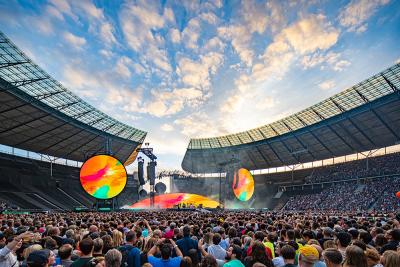Last year, British super band Coldplay announced that the new tour, Music of the Spheres, would address some of the environmental issues that large-scale tours raise. In interviews, Coldplay frontman Chris Martin has said that the tour would try to reduce its carbon footprint by 50% by adopting solar panels, kinetic flooring that produces power when people dance, and stationary Linus bikes that fans can ride to power the lighting on the C stage.
RELATED: Sooner Routhier Creates "Heavenly" Lighting Design For Coldplay
Live Design talked to the designers about their involvement with the tour, and how they adopted a sustainable approach.
Co-creative director (with Phil Harvey), and production designer Misty Buckley has a long history with Coldplay, designing both live and recorded performances for the band for more than 10 years. Buckley describes the first project she worked on.
“I designed a music video for the ‘Christmas Lights’ single in 2010. We had about two weeks to turn it around from design to realization. I created this really complicated magical traveling theater set and it was -2 degrees when we filmed it one night on the South Bank, London. We filmed all through the night as it needed so much choreography and technical coordination. I thought the band would never employ me after that, having endured this cold long winter night, but they loved it. It turned out to be a great success and fortunately I was invited to join their creative team with Phil Harvey.”
Buckley says that the band has a clear idea of what each show should be, and for the Music of the Sphere’s Tour, “The brief was to create a universe of its own. We wanted to create a sustainably-minded tour that was also going to transport the audience to a place of pure joy, love, and other-worldliness.”

The designer says the creative team took as its starting point Pythagoras’ notion of the Music of the Spheres. “That the sun, moon, and planets create sounds and harmonies that are not audible to humans but can be heard by our souls. We then explored music in space and went into a whole amazing creative wormhole of time, space, music and aliens. That led to the concept of alien music festivals in space, love, people, and togetherness. It was a really mad and wonderful creative thread.”
Once those concepts were in place, Buckley sketched her ideas for the band, and then created CAD files of images the band liked. “We kept going until the geometry worked, then we added the alien hieroglyphs and all the different languages associated with the planet map on the album artwork. Each planet has its own language, concept, and emotion.”
Buckley concedes that creating a sustainable tour is a challenge because touring is, “inherently unsustainable,” but adds that, “On a personal level, it’s very important to me, so it was a welcome challenge to actively bring those values in to the design and the touring industry.” One example Buckley gives is a central element of the design which consisted of inflatable LED spheres constructed with groundbreaking technology developed by PRG's Frederic Opsomer. “They are inflatable screens that basically pack down to take up very little truck space, despite their impressive size when inflated,“ she says
These are four, 50-foot LED spheres that hang along the back wall of the stage that was designed with energy efficiency in mind. They compliment two 35-foot-diameter circular screens, and an 80-foot LED wall.
Reducing the number of trucks was one effective way to cut the carbon footprint by 50%, and this was made easier by advances made in touring technology. David Kennedy, special effects designer, says, “So many of the effect devices are becoming smaller and more efficient. We’re getting more units on shows while using far fewer transportation resources. The main lasers on this show are a quarter of the size of similarly bright units we toured MX with and the new smaller units are actually brighter. The confetti blasters we are using provide nearly the height and power of dispersion as the ones we used previously, and do so using half as much gas. The units are smaller as well.” The tour uses some pyro, but even here improvements have been made. Kennedy says, “We’ve made product decisions based on using the most eco-friendly versions of specific pieces whenever it’s possible. The lift charges in most of the product are less ecologically impactful and we also need less of it to achieve the same heights.”
The eco-friendly approach extended to audience wristbands, choosing a custom product from PixMob. Shaheem Litchmore, lighting operator/programmer and PixMob wristband programmer, says, “They are the world’s first compostable plant-based plastic wristband. These innovative wristbands are controlled with our GrandMA 3 lighting console; and the signal is delivered via strategically placed IR washes and IR moving heads that live within the lighting rig.”
Buckley concludes, “These are just part of the incredible work that Coldplay are doing on a wider level with all their sustainability initiatives. Not to mention the inclusivity and diversity schemes. The last two and a half years has been hugely inspiring to be a part of these ideas and initiatives.”
- Co-creative Directors - Misty Buckley and Phil Harvey
- Production Designer - Misty Buckley
- Lighting Designer - Sooner Routhier
- Special Effects Designer - David Kennedy
- Lighting Programmers - Joe Lott, Matt Kemp, Shaheem Litchmore
- Lighting Operator - Shaheem Litchmore
- PixMob Wristband Programmer - Shaheem Litchmore